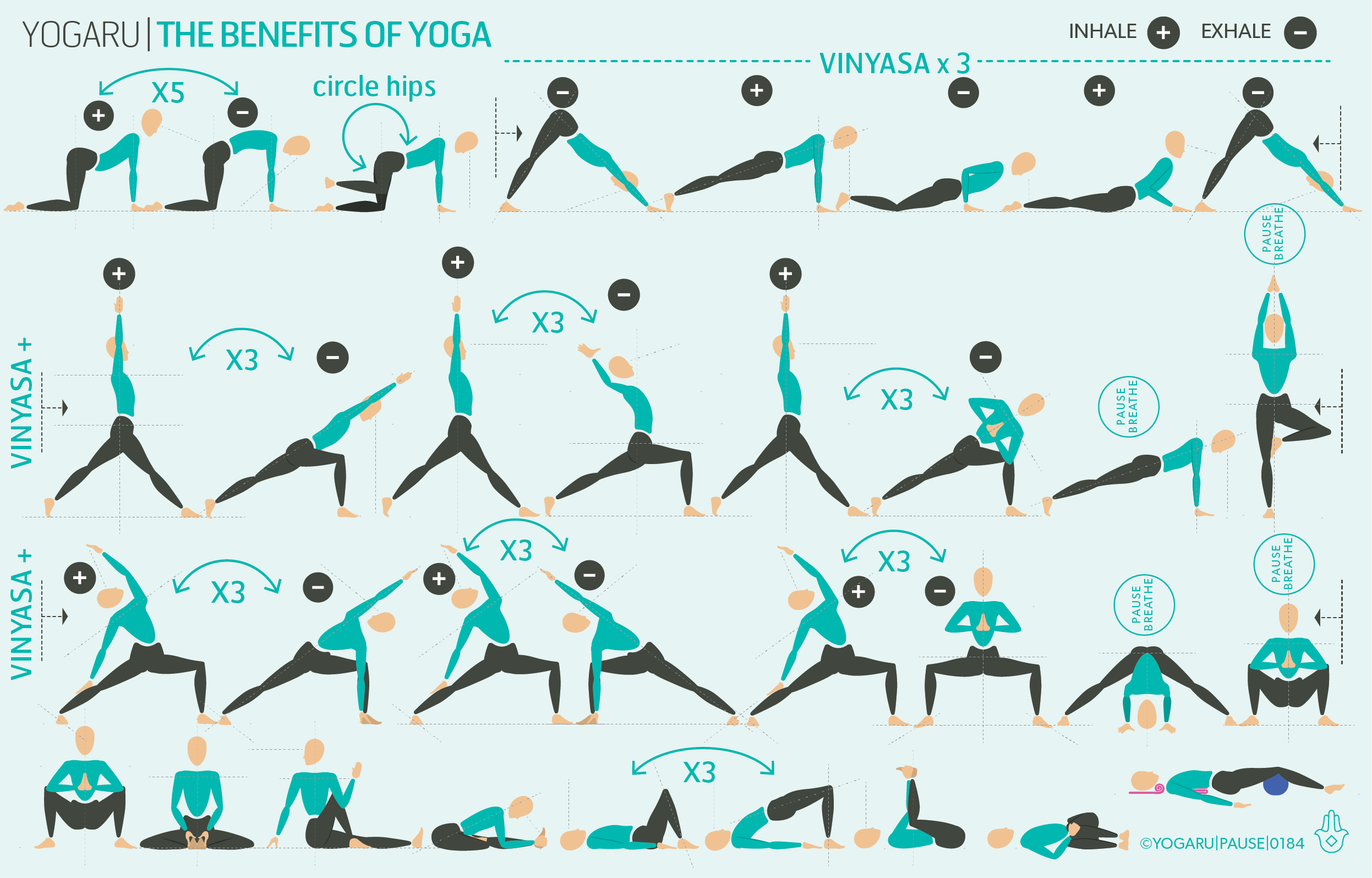BOUNDLESS BENEFITS
There are endless benefits to practising yoga, some are evidence based, and others are observations from the long history of yoga practitioners over the last 5,000 years. Research can answer the ‘what, why and how?’ of yoga through a scientific lens. It is an invaluable tool when we are looking at how to prescribe the yoga practice in a clinical setting, as yoga teachers, and in our own personal practice too. Research is in its infancy compared to the practice itself, which has benefited yogis for millennia. There is so much we know about the human body and mind, and even more yet to be discovered. Combining research with our human experience of yoga allows us to tailor a personal practice.
In my experience yoga is one of the best practices for your overall physical and mental wellness. It is a prescriptive practice with many different modalities to draw from – stretching, strengthening, mobility, stability, restorative, MFR – depending on your specific needs. We are rarely the same person each time we step on our mat, so the practice needs to be adaptable to how our day, week, year is going. What do you bring with you to your mat and how can your practice support you?
A CROSS SECTION
Over the years my practice has evolved and become my therapeutic method for meeting my ever changing physical and mental needs. Although there are many more, this is a cross section of my favourite benefits that I use personally, and as inspiration for my sequences and classes. You will notice the root is often similar for each of the benefits listed below – sometimes it is the flowing movement, sometimes it is pausing in a pose, sometimes it is the breath, sometimes it is consciously relaxing and sometimes it is a combination of all, or a few, of these components of the practice.
1. Balances nervous system
Yoga's positive effect on the nervous system is in my opinion the most important benefit of yoga. The nervous system is our communication highway and is also responsible for initiating all bodily functions. It is the conductor that brings the symphony of our systems together in harmony. Flowing movement, taking time to pause, consciously breathing and consciously relaxing all stimulate the main nerve of the parasympathetic ‘rest and restore’ nervous system response – the vagus nerve. The vagus nerve is the longest nerve in the body and travels from the brainstem straight to the throat, heart, diaphragm, stomach, kidneys, liver, pancreas, gallbladder, sphincter and reproductive organs. Its job is to reduce heart rate and blood pressure, relax our airways, stimulate digestion and reproductive organs, and inhibit production of adrenaline and the stress hormone cortisol. All favourable conditions for the systems of the body to perform at their best.
2. Aids relaxation & eases stress, tension & anxiety
Flowing movement releases and eases physical tension and manages pain, while at the same time a deepened breath, particularly the exhale, stimulates the vagus nerve in the throat and the diaphragm. This triggers the parasympathetic ‘rest and restore’ nervous system response with all the benefits listed above. Restorative yoga is the king of yoga when it comes to consciously relaxing. It downregulates the nervous system to the rest & restore response. In restorative, with the aid of props, we consciously relax the body and mind to bring you into complete comfort and rest. This helps you build a malleable nervous system which can be active when needed and relax when needed.
3. Aids digestion
Flowing movement helps stimulate the whole digestion system. Pausing in twist and backbend poses are particularly beneficial. They gently squeeze the abdominal region, which stimulates the walls of the stomach to help with digestion and massages the muscles of the large intestine to help with elimination.
4. Increases circulation
Flowing movement, pausing in poses and consciously breathing help stimulate the cardiovascular and circulatory systems to pump blood around the whole body. This carries oxygen, nutrients, and hormones to all the cells, and removes waste products created in the metabolic functions. Pausing in twists, backbends and inversions are particularly beneficial. for the circulatory system. Twists and backbends press and release blood vessels which causes extra flow capacity, and inversions aid with venous return to the heart.
5. Boosts immune system
Yoga supports all the systems of the body and helps them to work together in partnership. It helps the digestive system absorb nutrition; the respiratory system to bring in oxygen; the circulatory system to transport oxygen and nutrients; and the lymphatic system to clean up and transport white blood cells. When the body is firing from all guns the immune system can do its important job of producing immune cells.
6. Builds strength
Both flowing movement and pausing in poses increases strength in many of the muscle groups of the whole body. Although light weights can also be used in a yoga practice, it mainly uses body weight against the forces of gravity to challenge and increase muscle tone and strength, along with bone & connective tissue strength. Standing poses and standing balancing poses strengthen the big muscles of the legs, improve our spatial awareness and our everyday ability to balance and manoeuvre.
7. Improves flexibility
Yoga moves the body in a wide variety of directions which helps increase flexibility more than many other movement practices and sporting endeavours. It works on our active range of movement (AROM), which is our range to move our joints without the help of an external force, and it works our passive range of motion (PROM), which is our range to be moved by with the help of an external force. Both active and passive range of motion are important for everyday mobility.
8. Builds focus & concentration
Flowing movement, and pausing to hold poses, works our focus and concentration. It also increases circulation to the brain which improves memory and cognitive ability. Standing balancing poses, and poses you find more challenging, are particularly good at forcing you to focus. The nerves of the brain work on a system of pathways. When we build and establish a focus and concentration path the brain is more able to reproduce this pathway in your day to day life off the mat too.
9. Increases energy
Consciously breathing a deeper breath and expanding our chest and lungs brings in more oxygen and increases circulation through the whole body – delivering oxygen and nutrients to all the cells. This initiates a metabolic reaction that creates ADP, or cell energy.
10. Improves sleep
Bringing together lots of the above benefits – balancing the nervous system, aiding relaxation and easing stress tension and anxiety – yoga helps improve our ability to fall asleep and the quality of our sleep. A strong practice earlier in the day can prepare the body for a good night's sleep, and a gentle practice, or restorative yoga, practised in the evening will help start the rest and relaxation process.
EXPLORING THE BENEFITS OF YOGA IN YOUR PRACTICE
Each pose family has its own special range of benefits. Some overlap with other pose families and some are unique to that specific pose family. This sequence has a selection of poses from each of the pose families so you will capture a good selection of benefits listed above. You will flow through mini sequences, pause in poses, consciously breathe using my ‘+’ and ‘-’ cues and consciously relax at the end in savasana. You may even notice some of your own specific benefits too not listed above. If you are interested in tailoring your practice to your needs a good place to start is to explore my Yoga Benefits Wheel poster. It is divided into 10 pose categories and covers 45 different benefits. It is where yoga becomes specific to your individual requirements and helps you navigate your wellness journey. You will also find lots of inspiration in some of my previous articles about building a home practice:
ALIGNMENT CUES
Have a read of the tips below and either print out the sequence or save it onto your device:
Use the breath guide in the sequence to help you link breath with movement in the flow. Inhale is indicated with a ‘+’, exhale is a ‘-”.
If there are specific poses that you would like to stay longer in, give yourself three deep breaths in those poses, and pick up the next pose with the allocated inhale or exhale as indicated by the sequence.
For a longer practice add in a Sun Salutations at the start of each mini flow or repeat each mini flow.
To save the images for personal use click and hold down the image until the ‘save image’ option appears; on Mac hold down ‘control’ and click the image to get the option box; on PC right click on the image to get the option box. Scroll down in the ‘option box’ and click ‘save image’.
Ruth Delahunty Yogaru





